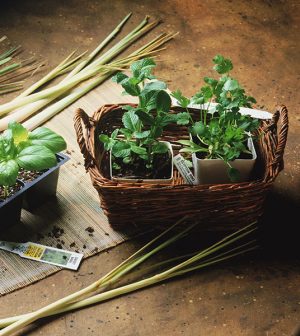- Navigating Your Midlife Crisis: Embracing New Possibilities
- City Raccoons Showing Signs of Domestication
- Mapping the Exposome: Science Broadens Focus to Environmental Disease Triggers
- One Week Less on Social Media Linked to Better Mental Health
- Your Brain Changes in Stages as You Age, Study Finds
- Some Suicide Victims Show No Typical Warning Signs, Study Finds
- ByHeart Formula Faces Lawsuits After Babies Sickened With Botulism
- Switch to Vegan Diet Could Cut Your Greenhouse Gas Emissions in Half
- Regular Bedtime Does Wonders for Blood Pressure
- Dining Alone Could Mean Worse Nutrition for Seniors
Essentials for Growing Tasty Herbs on Your Windowsill

Whether you have a dedicated space in an outdoor garden or just a few buckets on a small patio, there’s nothing quite like having your own herb garden for giving your cooking fresh flavor boosts.
But what if you live in an apartment or in a cold climate that can’t sustain outdoor herbs in the winter?
The answer is to create an indoor herb garden, even if it’s a small selection grown on a windowsill. Here’s how to get started.
First, decide on your herbs. Pick the ones you’ll use most often, and buy from a reputable nursery or garden center. Because growing from seeds can be hit or miss, use started plants. Check growing instructions on the label or insert that comes with each plant to see how much water it needs. This will help you group your herbs appropriately. Rosemary, for one, likes drier conditions, so it won’t mix well in the same planter with basil, which likes more water and fertilizer.
Now, select your planters. Window boxes should be about double the size of the containers the herbs came in. A hanging window box is great for a tight space. Whatever the style, make sure there’s a drainage hole in the bottom and a pan to catch any excess water.
Replant. To repot your herbs, fill your planters halfway with potting soil. Then use a large spoon to make hollows in the dirt where you’ll place each plant. Once the plants are in place, cover with more soil and press down firmly so the roots won’t be exposed to the air. Water liberally and set the planters in place. Water whenever the soil feels dry to the touch at a depth of about one inch.
Soon, when you need herbs for a recipe, you’ll be able to just grab a pair of shears and snip.
More information
The University of Illinois Extension has more on growing an herb garden and how to preserve and cook with them.
Source: HealthDay
Copyright © 2025 HealthDay. All rights reserved.










